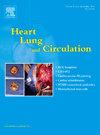Intracoronary Versus Intravenous Low-Dose Tirofiban in Patients With ST-Elevation Myocardial Infarction: A Meta-Analysis of Randomised Controlled Trials
IF 2.2
4区 医学
Q2 CARDIAC & CARDIOVASCULAR SYSTEMS
引用次数: 0
Abstract
Background
This meta-analysis aimed to evaluate the effects of intracoronary (IC) low-dose tirofiban versus intravenous (IV) administration on clinical outcomes in patients with ST-segment elevation myocardial infarction (STEMI).
Methods
All published randomised controlled trials (RCTs) comparing the effects of IC low-dose tirofiban (a bolus of ≤10 ug/kg) versus IV administration in patients with STEMI were identified by searching PubMed, EMBASE, Cochrane Library, and ISI Web of Science from inception to June 2023, with no language restriction. The risk ratio (RR) with 95% confidence intervals (CI) and the weighted mean difference (WMD) with 95% CI were calculated.
Results
Eleven RCTs involving 1,802 patients were included. Compared with the IV group, IC low-dose tirofiban was associated with improved major adverse cardiac events rate (RR 0.595, 95% CI 0.442–0.802; p=0.001), left ventricular ejection fraction (WMD 1.982, 95% CI 0.565–3.398; p=0.006), thrombolysis in myocardial infarction (TIMI) flow grade (RR 1.065, 95% CI 1.004–1.131; p=0.037), and TIMI myocardial perfusion grade (RR 1.194, 95% CI 1.001–1.425; p=0.049). The two groups had no significant difference in bleeding events (RR 0.952, 95% CI 0.709–1.279; p=0.745).
Conclusions
Intracoronary low-dose tirofiban administration may be a safe and effective alternative to IV administration in STEMI patients.
ST段抬高型心肌梗死患者冠状动脉内治疗与静脉注射小剂量替罗非班治疗的比较:随机对照试验的 Meta 分析。
研究背景这项荟萃分析旨在评估冠状动脉内(IC)小剂量替罗非班与静脉(IV)给药对ST段抬高型心肌梗死(STEMI)患者临床预后的影响:方法:通过检索PubMed、EMBASE、Cochrane Library和ISI Web of Science,确定了所有已发表的随机对照试验(RCT),这些试验比较了IC低剂量替罗非班(栓剂量≤10微克/千克)与静脉给药对STEMI患者的影响,从开始到2023年6月,没有语言限制。计算了风险比(RR)及95%置信区间(CI)和加权平均差(WMD)及95%置信区间:结果:共纳入 11 项 RCT,涉及 1802 名患者。与静脉注射组相比,IC低剂量替罗非班与主要不良心脏事件发生率(RR 0.595,95% CI 0.442-0.802;P=0.001)、左室射血分数(WMD 1.982,95% CI 0.565-3.398;P=0.006)、心肌梗死溶栓(TIMI)血流分级(RR 1.065,95% CI 1.004-1.131;P=0.037)和 TIMI 心肌灌注分级(RR 1.194,95% CI 1.001-1.425;P=0.049)。两组在出血事件方面无明显差异(RR 0.952,95% CI 0.709-1.279;P=0.745):结论:在 STEMI 患者中,冠状动脉内小剂量替罗非班给药可能是静脉给药的一种安全有效的替代方案。
本文章由计算机程序翻译,如有差异,请以英文原文为准。
求助全文
约1分钟内获得全文
求助全文
来源期刊

Heart, Lung and Circulation
CARDIAC & CARDIOVASCULAR SYSTEMS-
CiteScore
4.50
自引率
3.80%
发文量
912
审稿时长
11.9 weeks
期刊介绍:
Heart, Lung and Circulation publishes articles integrating clinical and research activities in the fields of basic cardiovascular science, clinical cardiology and cardiac surgery, with a focus on emerging issues in cardiovascular disease. The journal promotes multidisciplinary dialogue between cardiologists, cardiothoracic surgeons, cardio-pulmonary physicians and cardiovascular scientists.
 求助内容:
求助内容: 应助结果提醒方式:
应助结果提醒方式:


